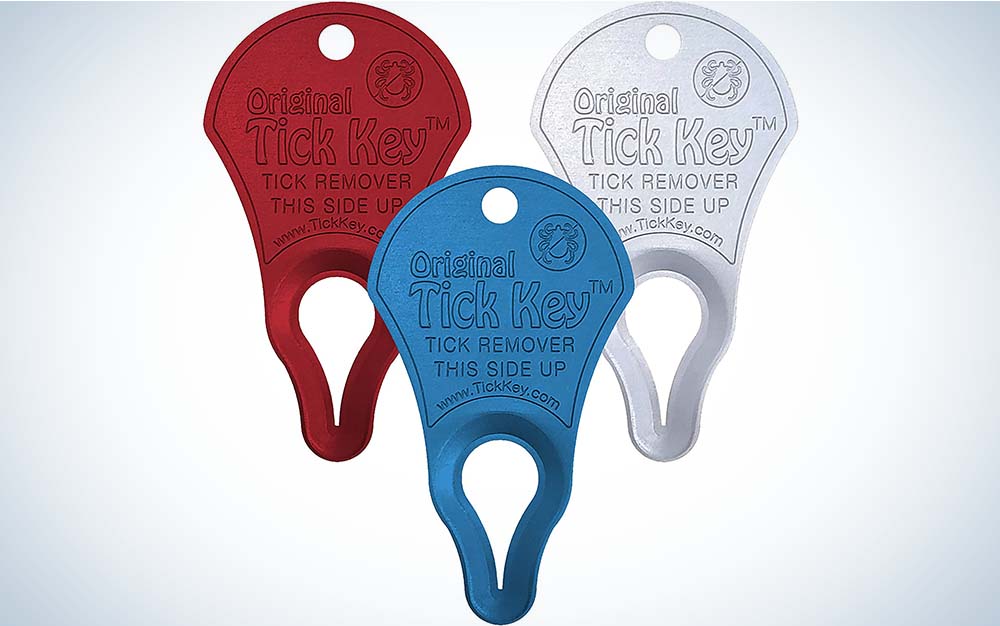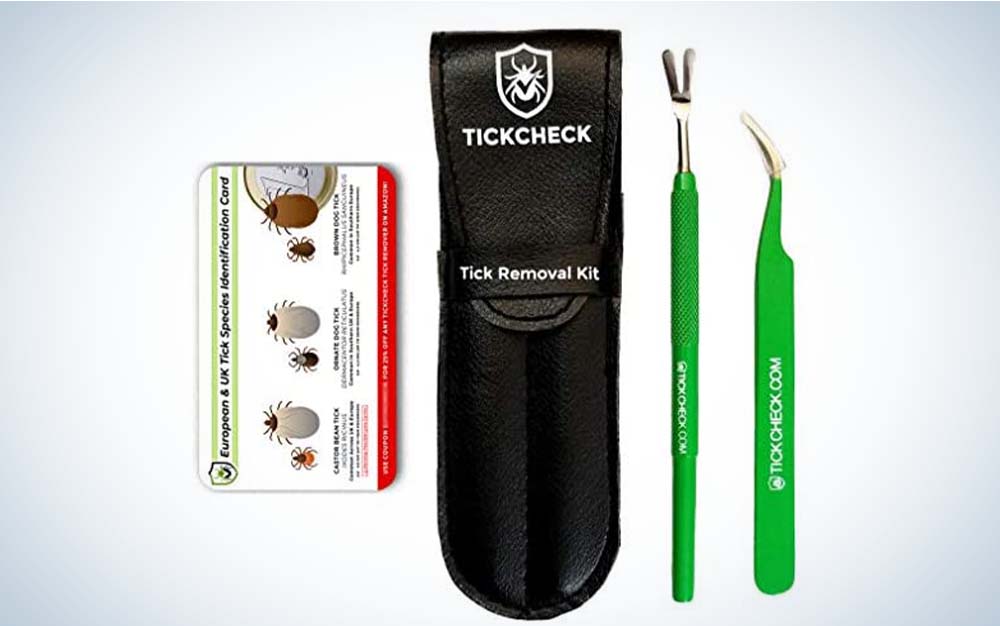We may earn revenue from the products available on this page and participate in affiliate programs. Learn More ›
If you find a tick buried in your skin after a long day outdoors, the natural reaction might be to panic and rip it out. Lyme disease, alpha gal, Rocky Mountain spotted fever, and other tick-borne illnesses are no joke. But knowing how to remove a tick quickly and safely can be the difference between a harmless bite and an infection.
First, grab whatever tick-removing tool you have on hand. That might be a pair of tweezers, a Tick Key, or something else. (We’ll get to other emergency tick tools in the roundup below.) Grab onto the tick as close to the skin as possible and pull straight up until it releases. Check the tick to see if its head is still attached to its body. Also look over the bite area with a flashlight to see if the head might still be burrowed in the skin. If that’s the case, try to remove the head with tweezers. If that doesn’t work, apply an antibiotic ointment or rubbing alcohol to disinfect the bite area.
Use a Credit Card to Remove a Tick
If you’re in a pinch and don’t have access to tweezers or a Tick Key, there are a few substitutes that you’re likely to have in your pocket. First, you could slide the edge of a credit card, driver’s license, or other plastic card under the tick’s body to help lift it off the surface of your skin. Clamp your thumbnail down on top of the tick as close as you can get to the skin, like you would with tweezers. Pinch the tick between the card and your thumbnail and pull straight up. If you have access to a knife, cut a small V-notch in the edge of the card and use it the way you would a Tick Key.
Use Thread or Floss to Remove a Tick
You can also use a piece of thread or floss. If you you have zero tools at your disposal and find a tick buried in you, rip a piece of thread from your clothing or use a few strands of hair. Loop the string around the tick’s head, right at the base where it’s embedded in the skin. Take one end of the string in each hand and pull, tightening the loop slowly until the tick pops out.
What to Do After a Tick Bite
No matter how you remove the tick, watch the bite area closely in the days that follow. The Centers for Disease Control and Prevention don’t recommend getting the tick tested for a few reasons. First, even if a tick is infected, it might not have passed anything to you. Second, if the tick isn’t infected, this could create a false sense of security that could cloud your judgment of any symptoms that a different tick bite might have caused. Lastly, if you did pick up an illness from the bite, symptoms will likely show before you get results back, anyway. The best thing to do is to be tick aware and monitor yourself for symptoms. —Katie Hill
Ticks and Diseases
Some of the most well known ticks in the United States are the Lone Star, American Dog, Blacklegged(Deer), Gulf Coast, Brown Dog, and Asian Longhorned. The latter was discovered in 2017, but so far has not been known to transmit diseases to humans. The other five can carry and transmit a variety of diseases from the aforementioned Lyme and RMSF to the Heartland virus, tularemia, anaplasmosis, Powassan, and rickettsiosis. The Blacklegged and Lone Star ticks can also cause, in rare cases, Alpha-Gal Syndrome, which produces an allergy to red meat in the infected host.
Ticks are tough critters, and cold weather doesn’t kill them until temperatures fall between 14 and -2 degrees. They are more inactive in winter but may find a host, such as a burrowing rat, or even larger ones like a moose or bear. But during the spring and summer, ticks are at their peak activity. Fire or controlled burns can be used to help control tick numbers, but that doesn’t mean they completely disappear, which is why it’s important to know the best way to remove a tick and have a few options on hand if you do end up with one latched to your skin.
How to Remove a Tick: Use These Tools
If you’re bitten by a tick, don’t use folklore or Granny’s Secret Tick Poultice to remove it. Instead, the best way to remove a tick might require you to use one of the below tools, so you don’t leave part of the tick in your skin, which can lead to infection. I chose these tick removal products because I’ve used them, especially tweezers, in the field for years, and they work. In tight situations, I’ve also plucked ticks off with my fingers, but I don’t recommend doing this unless you’re in a bind.
When they bite, ticks inject a mild anesthetic before embedding three barbed probes into your skin. That’s why you rarely feel a tick bite you. They can then feed on your blood for up to 48 hours, possibly transmitting a virus or bacteria into your body during the process. Severe symptoms might include fever, swelling, redness, rash, hives, itching, chills, headache, neck stiffness, nausea, or others. If you’re experiencing any of these symptoms, it might be time to drop your home remedy and see a doctor. —Alan Clemons
Best Way to Remove a Tick: Tick Key
Key Features
- Various color options
- Thin, lightweight
- Hole for keychain
Why It Made the Cut
The Tick Key is convenient, easy to store, and even easier to use.
Pros
- Plenty of grip
- Flat, scalloped edges remove ticks safely
- Works on humans or animals
Cons
- Bulky in pocket or keychain
Product Description
A couple of years ago, I got a Tick Key as part of a trail run registration pack. I keep it in my running vest because it’s lightweight and works even if I’m sweaty after a summer run. The flat butt of the Tick Key provides a good gripping surface to slip the scalloped edge under the tick’s body, and the thin end removes the tick and extracts the head quickly. You can then double-check to make sure nothing remains (using tweezers or a needle if need be) and follow up with antiseptic. The Tick Key removes ticks of all sizes and even works on pets or other animals with thick hair.
Best Way to Remove a Tick on a Budget: Tweezers
Key Features
- Lightweight
- Precise
- Available almost anywhere
Why It Made the Cut
Tick removal products typically aren’t expensive, and most people already have a pair of tweezers lying around their home, so the availability and cost make them the best way to remove a tick on a budget.
Pros
- Small, packs easily
- Flat edges remove ticks safely
- Removes other things too
Cons
Product Description
Tweezers come in different lengths and end shapes. You’ll want to get some with wider, flat edges so you don’t pinch the tick and leave part of it in your skin. Eyebrow tweezers specifically have wider gripping edges that are great for removing ticks. They’re inexpensive and available at grocery stores, pharmacies, and even larger chain gas stations, so you can find them almost anywhere. I keep tweezers in my truck and pack medical kit, and it’s not a bad idea to keep a pair in your hunting or hiking pack, especially for out-of-state or backcountry excursions.
Key Features
- Stainless steel
- Multiple tools
- Carrying case with tick ID card
Why It Made the Cut
The carrying case neatly keeps everything in one location, so you don’t have to fumble around your pack for a single thin pair of tweezers.
Pros
- An all-in-one kit
- Two removal tools
- Lightweight, convenient
Cons
Product Description
I really like this kit because you get a fine-tip tweezer for smaller species like deer ticks. The other tool has a thin, narrow v-shaped design for sliding under and removing larger ticks. The ID card offers clear, concise info so you can quickly identify the embedded tick. A portion of the proceeds also goes to Lyme disease research in the United States.
Key Features
- Keychain holder
- Crafted in the U.S.
- Stainless steel
Why It Made the Cut
Tweezers are great to remove or pick up small items, but these are specially designed for even more precision to extract even the smallest ticks.
Pros
- Pinpoint precision
- Attaches to keyring
- Removes more than ticks
Cons
Product Description
Tweezers are great for removing ticks, but these tweezers specifically have precision ground points that offer more pinpoint accuracy than most products for removing ticks. The durable, stainless construction should help prevent corrosion, and if you don’t lose them they should last a lifetime.
Best Way to Remove a Tick for Kids: Tick Twister
Key Features
- Specifically designed for tick removal
- Multiple colors and sizes
- Won’t spook kids
Why It Made the Cut
The special V-shape design easily and safely removes ticks without needing to touch them. This is great to use with kids, who might be spooked by sharp tweezers or other tools.
Pros
- Easily slips under a tick’s body
- Works with constant pressure, not twisting
- Works on large or small ticks
Cons
- No carrying case or keyring hole
Product Description
I really love this tool because it doesn’t require touching the tick, unlike some other products. The V-shape painlessly removes the entire tick, including mouthparts. You only have to slip it under the tick and lift gently but constantly. No twisting, squeezing or pinching required, though the product is designed to twist. You may want to stick these in a small resealable bag or first aid kit in your pack so you don’t lose them.
FAQs
Q: Do Tick Keys work?
Yes. The design of the Tick Key and similar products work by sliding underneath the tick’s body and plucking the head from a person’s skin without leaving it beneath the surface. You can attach it to a keychain or pack carabiner, too. Pack a Tick Key along with tweezers in a safety kit to keep in your pack or truck. They’re inexpensive enough to buy several of each in case you lose one.
Q: How do you remove a tick that is embedded?
To remove an embedded tick, use tweezers or another removal tool to grasp or get under the tick as close to the skin’s surface as you can. Pull upward with a steady, continuous motion until it breaks free. Don’t yank, twist, or jerk the tick from the body because this often leaves the head in the skin and can lead to serious infection. Use a light to make sure nothing remains of the tick in the skin.
Q: What do you do if you pull a tick out and the head stays in?
If you pull a tick out and the head remains in the skin, remove the head with tweezers or gently with the tip of a sterile needle. Once there’s nothing still stuck in the skin, clean the area with rubbing alcohol. If you can’t get the tick’s head out of the skin, contact your physician for assistance.
Final Thoughts on How to Remove a Tick
If you spend a lot of time outdoors, chances are you’re around ticks. To prevent having to use a tick removal tool, you should apply tick and insect repellent on your clothes and shoes. It also helps to tuck in your clothing where there are any openings so ticks don’t come into contact with your skin. Check your body for ticks after you spend time outdoors. If you get bitten, don’t flip out. Once you know how to remove a tick, you can use one of the products and tactics above and then get on with your day. Just make sure to monitor the bite area and your health for a few days.





